Key Points:
- Pointers are hunting dogs who sniff out and point to small game so that a hunter can find it.
- They are intelligent, medium-sized dogs who often make good pets.
- The different breeds of Pointers originated from a common ancestor in Spain.
A pointer dog is a hunting or sporting dog breed that stops and points at small game that a hunter might not be able to see. When in a pointer stance, the dog should be immobile and the head, body, and tail should be in a straight line. Some dogs also raise their paw. Because the prey is often a bird such as a grouse or a quail, these dogs are also called bird dogs. These types of pointer bird dogs are believed to have a common ancestor that originated in Spain, and their pointing instinct has been ingrained over hundreds of years.
Some retrieve game as well as point, while others such as the English pointer have only been raised to point. Lively, loyal, and obedient, these dogs tend to be on the larger side. Besides being good sporting dogs, many of them are excellent family pets. Read on for more information about different types of pointer dog breeds.
1. English Pointer

English Pointers are great for tracking small prey and their instinct is to point to the game, not to retrieve.
©Anna Pozzi – Zoophotos/Shutterstock.com
The name of this dog which was developed in the 17th century in Great Britain says it all. Originally trained for tracking hares, the English pointer is both slender and muscular. Its neck and shoulders are long and sloped, it has a wide chest, and its feet have arched, well-padded toes. It holds its tail in line with its back, and its head has medium-length, folded ears and a pronounced stop above the muzzle.
This pointer stands 24 to 27 inches at the shoulder and weighs between 44 and 66 pounds. Its coat is short but hard, with a pleasing gloss, and it’s allowed to come in several color types as long as they are joined by large areas of white. Because it’s such an energetic dog, the English pointer needs plenty of exercise if it’s adopted as a pet.
Read here for more information about the English pointer.
2. German Shorthaired Pointer
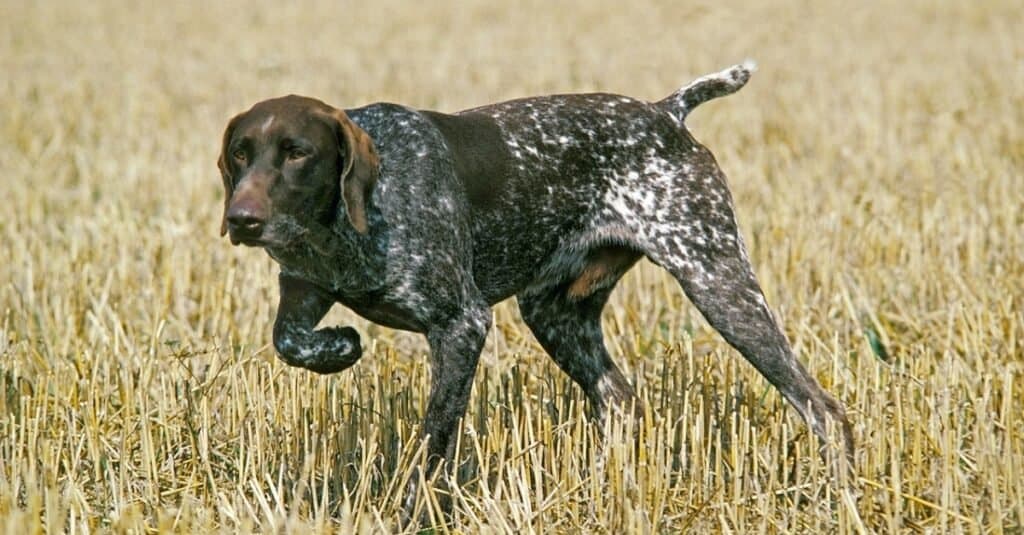
German Shorthaired Pointers are all-rounders and can hunt, point, and retrieve, and be used to hunt quarry of all kinds.
©iStock.com/slowmotiongli
Developed in Germany in the 1800s, this breed is similar to the English pointer. It stands 21 to 25 inches at the shoulder and can weigh between 45 and 60 pounds. As with most dogs, the females are a little bit shorter and lighter than the males. Its legs are powerful, and it is used for hunting game on land and in the water. Because it is used to retrieve waterfowl, it has webbed feet.
The German Shorthaired Pointer is an excellent dog for families, but like the English pointer needs a lot of exercise and space to run around. The coat is short and hard and though the dog sheds it is not considered a heavy shedder. The coat just needs some regular brushing.
An interesting side note: Because Dalmatians are relatively rare, their gene pool has become dangerously small and they have an increasing number of health defects as a result. In order to address this problem, some breeders have introduced German Shorthair pointers into their breeding programs. The result of this wider gene pool has been a vast improvement in the health and temperament of Dalmatians without losing any of their characteristic spots.
Go here for more information on the German Shorthaired Pointer.
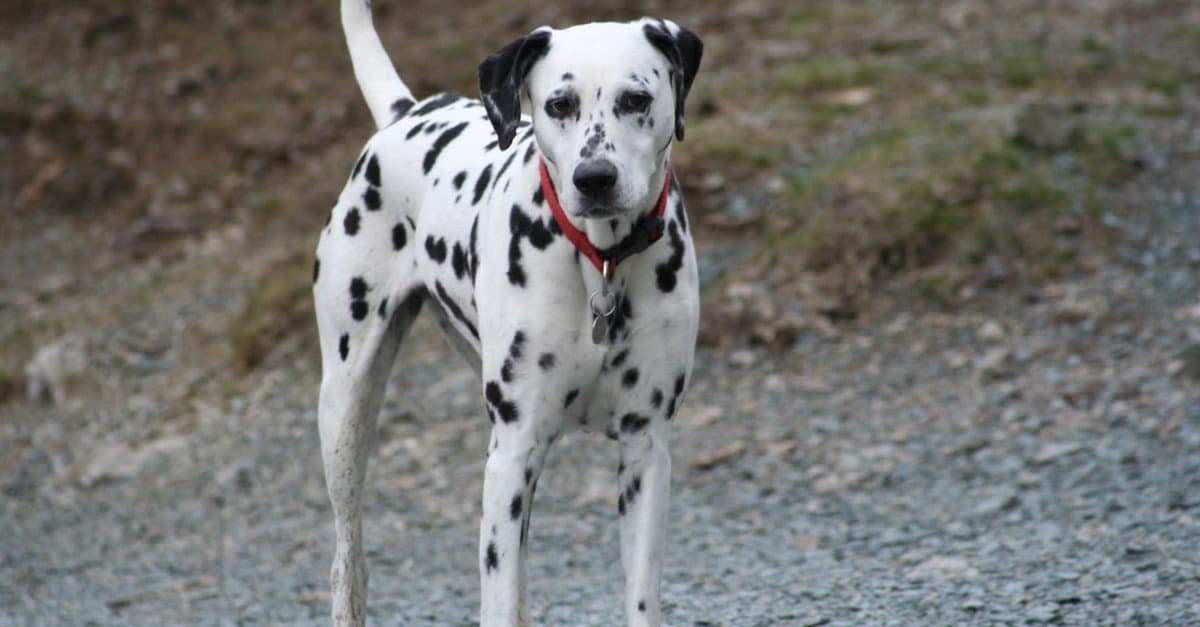
German Shorthair Pointers have been introduced into some Dalmation breeding programs to address health defects.
©Alex Fleming/Shutterstock.com
What Is the Difference Between a German Shorthaired Pointer vs. An English Pointer?
It is true that the German Shorthaired Pointer and the English Pointer look very much alike, and breeders believe that the German Shorthaired Pointer breed was improved by some English Pointer genetics somewhere down the line. The English Pointer may be a bit smaller and lighter than the German Shorthaired, which has a wide, deep chest and muscular legs. Another characteristic that separates the two dogs is that the German Shorthaired Pointer, like other German pointers, has webbed feet, since it also hunts in the water. Another difference is that the English Pointer doesn’t retrieve the game but only points.
3. Weimaraner
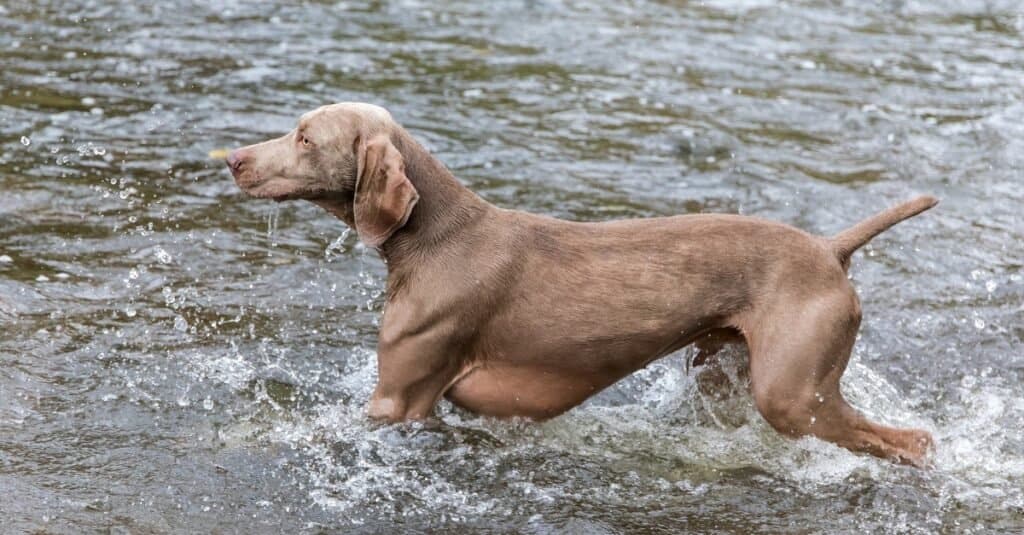
The Weimaraner is called the “gray ghost” of the dog world due to a ghostly coat, eye color and stealthy hunting style.
©iStock.com/MartinFredy
This beautiful, silvery gray sporting dog was also developed in Germany in the 1600s, though the story of just how it was developed is murky. It is not only a pointer dog but has been used to hunt and retrieve game. Its trademark coat can be short or somewhat long, with some fringing on the legs, the tail, and ears. The Weimaraner stands 22 to 27 inches high at the shoulder and weighs between 70 and 80 pounds, much of it due to its muscular build. Its eyes are famously amber or blue-gray, its back is level and clean, and it has a long muzzle, a long, strong neck, and deep and powerful shoulders.
For more information about the Weimaraner, go here.
4. Small Munsterlander
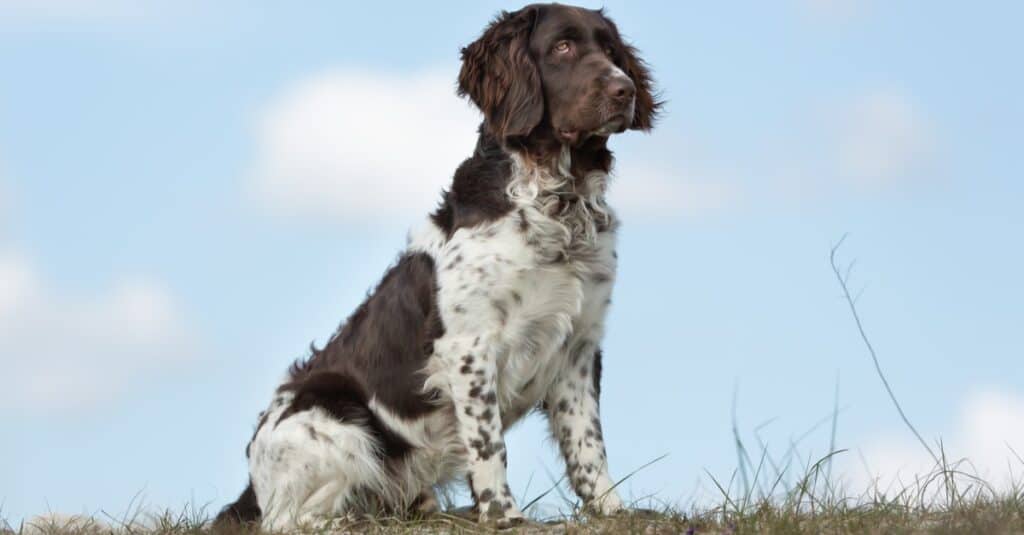
The Small Munsterlander originated in the 1800s and was prized for its pointing.
©BIGANDT.COM/Shutterstock.com
This is one of the types of pointer bird dog that has a long coat with lots of feathering on the tail and the legs, which makes it look more like a setter than a pointer. It can be differentiated from the Larger Munsterlander because it is, of course, smaller at 19 to 22 inches high at the shoulder and lighter at around 33 pounds. It’s also restricted to colors of liver and white with some ticking if it’s shown. Its front legs are straight and its feet are tight and well-padded. The Small Munsterlander originated in the 1800s and was and is prized for its pointing. This good-natured dog was developed in the Westphalia area of Germany.
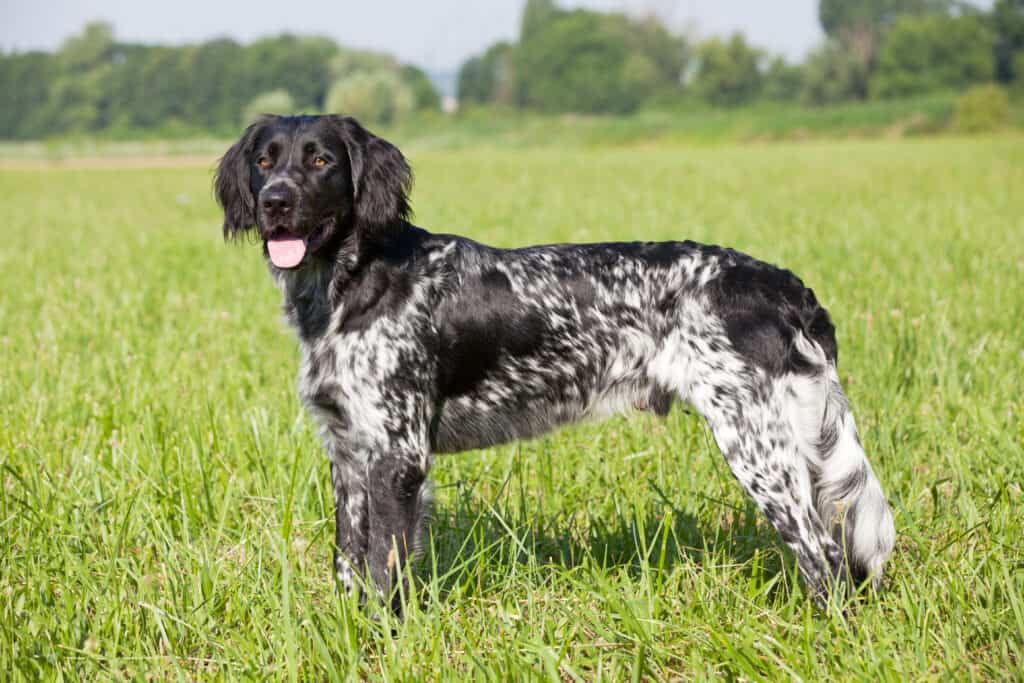
The Large Munsterlander has longer legs and a shorter body than the small version, which has shorter legs and a longer body.
©Lenkadan/Shutterstock.com
5. Large French Pointer
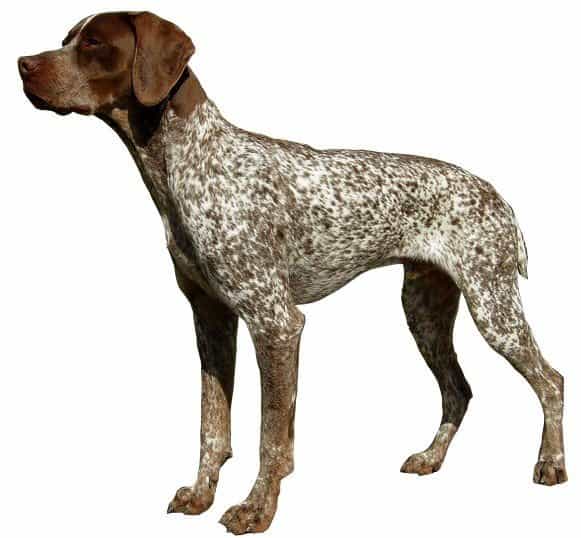
Pointers are bred primarily as hunting companions.
©Desaix83 / CC BY-SA 3.0, Wikimedia Commons – License
This dog, bred for tracking and pointing, originated in France in the 1600s and looks much like the German shorthaired pointer. However, its muzzle is wider and more angular, its skull is a bit rounder, and it appears to have pleats on its ears. The fur of its body is dense and thick, though short, but the hair on its head is fine. It has dewlaps that call to mind a scent hound. In fact, the large French pointer’s sense of smell is exemplary. The dog nearly went extinct, but its numbers are increasing.
6. Wirehaired Pointing Griffon
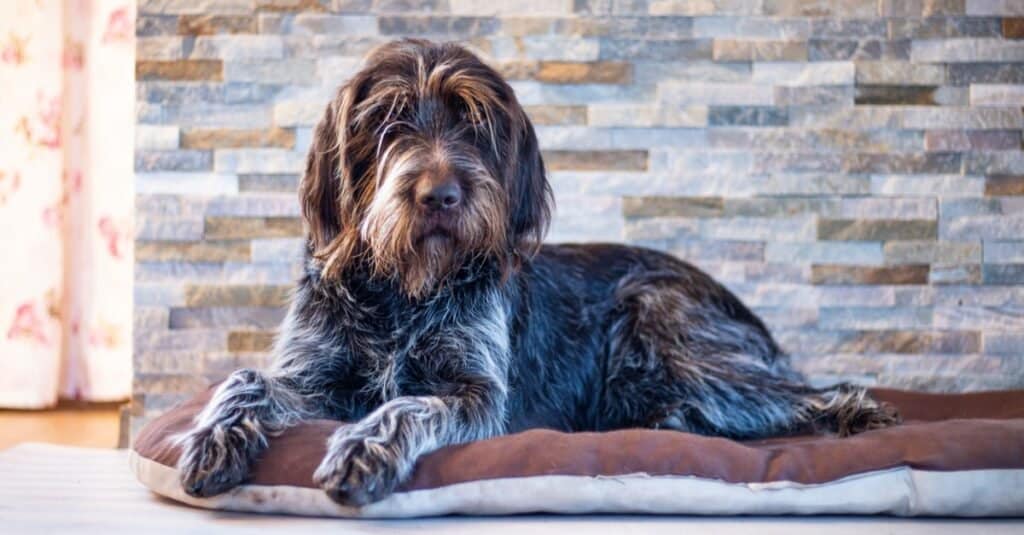
Wirehaired pointing griffons are famously known as a supreme gundog.
©Vaclav Sonnek/Shutterstock.com
This pointer, which has a rather messy coat, originated in France but was developed by a Dutchman, Eduard Korthals. It has powerful legs for tracking and a large head adorned with a thick beard and bushy eyebrows. Besides pointing, this dog also retrieves and hunts rats and foxes. It stands between 22 and 24 inches high at the shoulder, weighs between 50 and 60 pounds, and is known for its intelligence.
7. Cesky Fousek

The Cesky Fousek is believed to be an ancient dog, first setting its roots centuries ago in the time of the Kingdom of Bohemia.
©Jan Danek jdm.foto/Shutterstock.com
This pointer originated in Czechoslovakia in the 1800s. It looks much like the Wire-haired Pointing Griffon except it is taller and heavier, and its legs are longer in proportion to its body. The Cesky Fousek also has a somewhat messy, bristly coat that is longest over its back and flanks. It also has a thick undercoat and long ears that are placed further back on its head. It is an energetic dog that needs to work to be happy, and unlike some types of pointer bird dogs, doesn’t make the best pet.
8. Auvergne Pointer
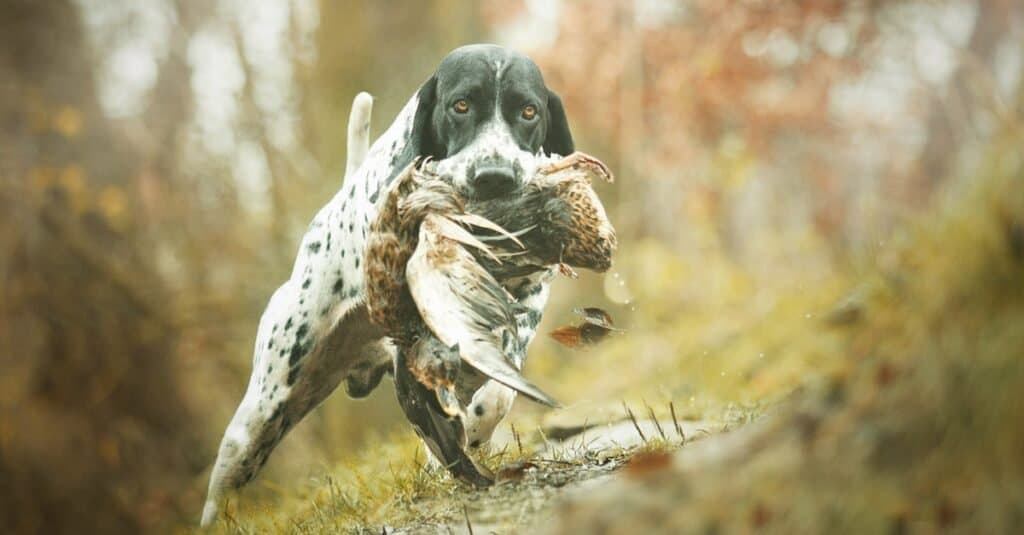
The Auvergne Pointer has a large head in proportion to its body and powerful hindquarters.
©Best dog photo/Shutterstock.com
This sporting dog has the coloration and markings of the English and German short-haired pointers, but it is a heavier set. It has a massive head in proportion to its body, with a round skull and a distinct stop. It has a short but glossy coat, powerful hindquarters, and large, well-cushioned feet. The area around the eyes and the ears must be black for the dog to be shown, and a coat pattern called charbonnée is a plus. These are bluish spots that come about when black and white hairs overlap. The Auvergne pointer was developed in France in the 1800s.
9. Old Danish Pointer
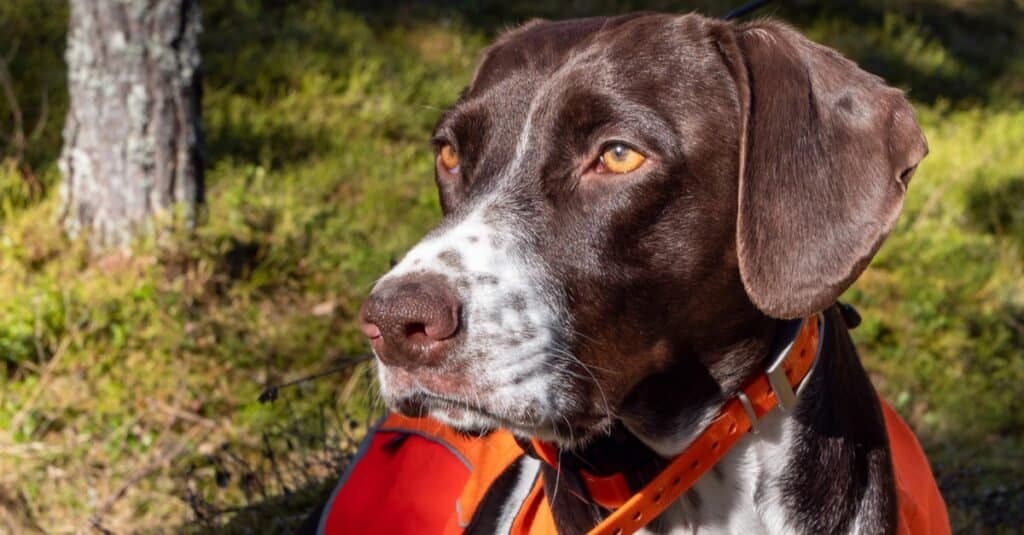
The Old Danish Pointer is a calm, steady dog with an incredible amount of determination and bravery.
©Johnny Randen/Shutterstock.com
Among the different types of pointer dogs, this dog stands out because of the dewlaps around its neck. The dewlaps make this pointer’s sense of smell exceptional, as the folds of skin waft scent molecules up into the dog’s nose. Besides pointing, it is used for tracking wounded prey. Though the Old Danish Pointer isn’t as tall as other pointers as it stands 20 to 23 inches high at the shoulder, it is robust and muscular. Unlike the English pointer, it holds its tail down though its back is also straight. It also has a liver-colored nose, long, rounded ears, and a deep chest. The dog was developed in Denmark in the 1700s.
10. Perdigueiro Portugueso
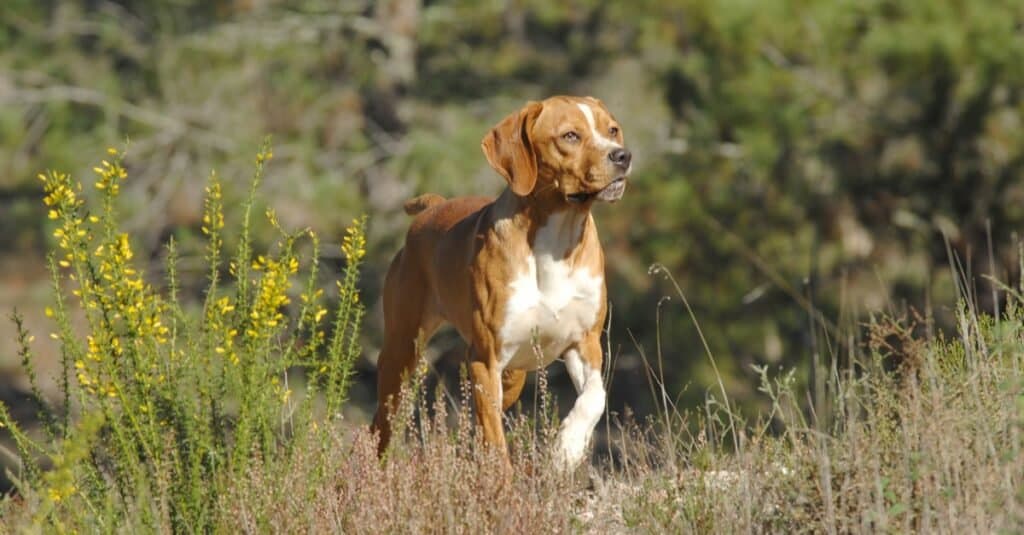
It was once forbidden to own a Perdigueiro Portugueso unless you were royalty.
©Pedro Monteiro/Shutterstock.com
This breed of pointer dog was so good at its job that game, particularly the partridges it was named after, became scarce. It was actually forbidden to own the Perdigueiro Portugueso unless you were royalty. This happened in the 16th century, and the breed is far older than that, having been developed in Portugal in the 1200s.
This biddable and energetic dog stands 20 to 22 inches at the shoulder and weighs between 35 and 60 pounds. Its ears are large, folded, and shaped like rounded off triangles, and the muzzle is broad and short with a large nose with large nostrils. The neck is straight and powerful, and its body is short and broad with a bit of a curve to its back. There are long-haired and short-haired versions of the Perdigueiro Portugueso, but of the different types of pointer dogs, the long-haired Perdigueiro Portugueso is rare now.
How to Care for Pointer Dog Breeds
Pointers are a powerful breed and require a lot of exercise and physical activity to stay healthy. Here are some care tips for properly taking care of your pointer dog.
Health
Pointer dog breeds are prone to having eye issues, thyroid, and hip dysplasia. Although an experienced breeder will keep an eye out for such issues early on, it is a good idea to take your pointer dog on regular vet visits. Apart from that, ensure that the teeth of the pointer dog are brushed every day with toothpaste for dogs.
Just like any other large dog breed with a big chest area, the pointer dog breeds can experience sudden bloat which can turn deadly for them. As a responsible dog owner, you should keep an eye out for early signs of bloat and take preventive measures.
Nutrition
Depending upon the breed, metabolism, and level of activity, a pointer dog should be given adequate food that is high quality. Apart from packaged food, they can also be given a diet of chicken, fish, turkey, and eggs. You can also give them boiled sweet potatoes, and brown or white rice. However, avoid food that can cause bloating, such as potatoes, onion, garlic, peas, etc.
Exercise and Training
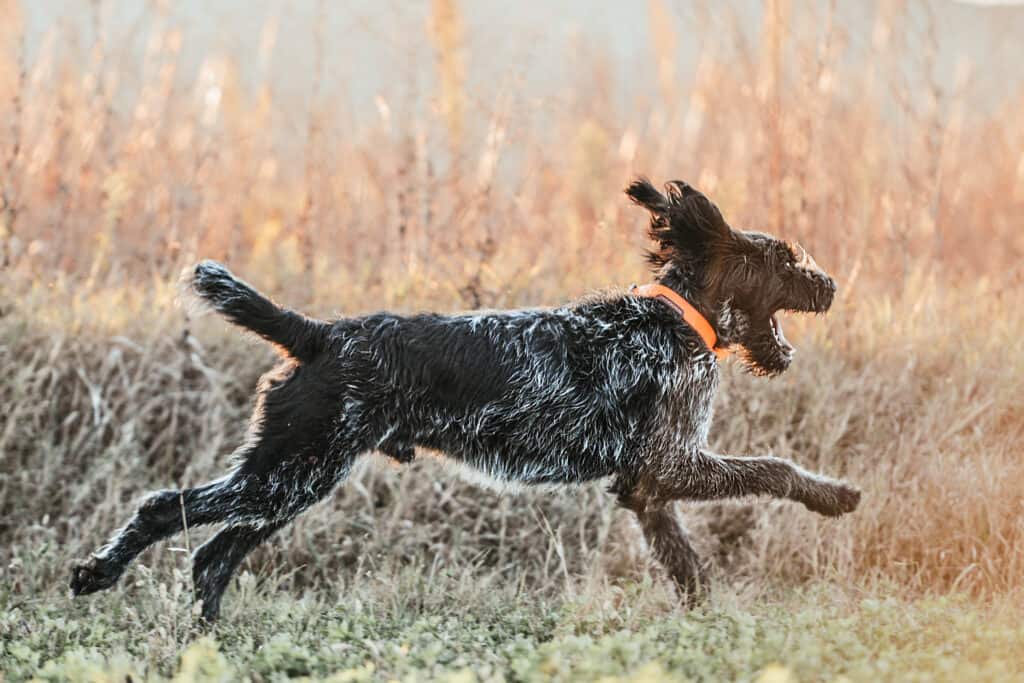
Pointer dogs such as the German Wirehaired Pointer, need plenty of exercise and play sessions.
©iStock.com/Credit:Photographer and Illustrator
Pointer dogs thrive outdoors and that is why your home should ideally have a fenced backyard where they can run around and lay. They also need lots of walks and vigorous play sessions. Pointer dogs enjoy activities such as tracking, field events, obedience training, agility training, and other canine sports.
Because of their natural proclivity to serve, pointer dogs are a great breed to be trained as service dogs, therapy companions, and search-rescue dogs.
Grooming
Pointer dogs usually have short, dense, and glossy coats that require brushing once a week and cleaning with soft gloves. Their ears should also be checked and cleaned regularly to maintain hygiene. Their nails have to be trimmed regularly to keep them comfortable and clean.
Summary of Types of Pointer Dog Breeds
If you are looking for a good hunting dog or a nice family pet and you are able to provide a home with plenty of fresh air and exercise, one of these Pointers could be a perfect match. Look for a reputable breeder to help you find the right pup for you.
| Number | Pointer Breed |
|---|---|
| 1 | English Pointer |
| 2 | German Shorthair Pointer |
| 3 | Weimaraner |
| 4 | Small Munsterlander |
| 5 | Large French Pointer |
| 6 | Wirehaired Pointing Griffon |
| 7 | Cesky Fousek |
| 8 | Auvergne Pointer |
| 9 | Old Danish Pointer |
| 10 | Perdigueiro Portugueso |
The photo featured at the top of this post is © iStock.com/vik898
Ready to discover the top 10 cutest dog breeds in the entire world?
How about the fastest dogs, the largest dogs and those that are -- quite frankly -- just the kindest dogs on the planet? Each day, AZ Animals sends out lists just like this to our thousands of email subscribers. And the best part? It's FREE. Join today by entering your email below.
Thank you for reading! Have some feedback for us? Contact the AZ Animals editorial team.







